Our Journey
Although the Universe is very, very big, its component parts are very, very small.
Telescopes
Telescopes that use glass 
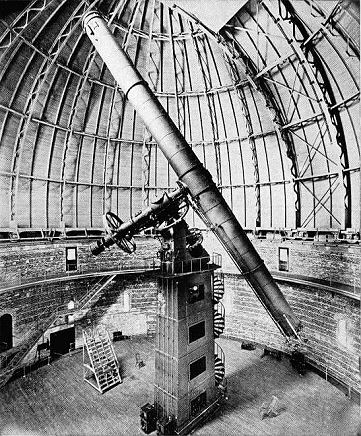
For telescopes to form bright images from very faint objects, lens diameters had to drastically increase. Grinding large-diameter glass lenses, however, has limitations, even with today's technology. The largest operating refracting telescope is the 40-inch (102-centimeter) refractor telescope at the Yerkes Observatory of the University of Chicago.
Fortunately, during the early 1600s, several people had proposed the idea of a curved mirror that could enlarge celestial images. Later in the 1600s, Isaac Newton built a curved telescope mirror made of an alloy of tin and copper. Newton, consequently, is assigned the honor of being inventor of the
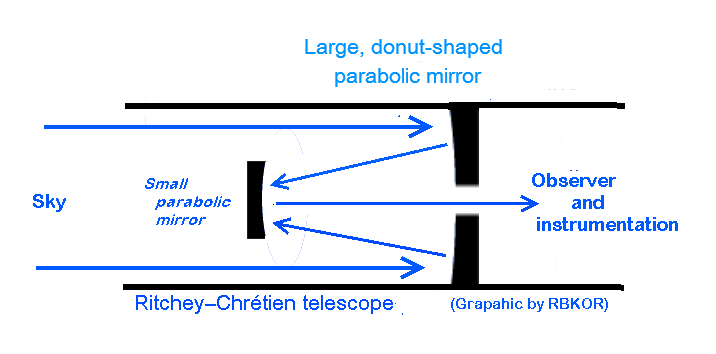
One of the major advantages of modern reflector telescopes is that they produce sharper and less distorted images than refracting telescopes. Early, refracting telescopes produced halos of light around bright objects, much like what a person suffering from cataracts experiences. Today, small, multi-lens refracting telescopes can produce decent images, but refractors become more and more difficult to manufacture as they become larger and larger.
Another reason for the popularity of reflector telescopes is that they are much smaller in size than an equivalent refracting telescope. Small, compact 10- or 12-inch reflector telescopes are quite powerful, yet light weight, and are popular among amateur astronomers.
Extending Our Vision
So far in this story, references to both refracting and reflector telescopes have focused solely on telescopes that can pass
The problem is that our eyes can see only a tiny sliver of all the electromagnetic radiation (EMR) around us in our daily lives. Wavelengths outside of the range of
For us to see the world beyond visible light, we need special
Everyday Interactions with EMF
- ⚬
300 meters (or 1 megahertz; MHz) :
AM broadcast, marine navigation, marine communications; - ⚬
1 meter (100 megahertz; MHz) :
FM broadcast, air traffic control, TV broadcast; - ⚬
15 centimeters (2 gigahertz; GHz) :
Cell phones, GPS (global positioning system) microwave ovens, garage-door openers, computer central processors, radar, satellite communications; - ⚬
500 nanometers (15 pitahertz; PHz) :
Visible light is sensed with eyes in animals and sensors in plants; several species in the animal kingdom see in infrared light (e.g. rattle snakes) and some insects see in ultraviolet light, e.g. honey bees; - ⚬
1 nanometer (300 petahertz, PHz) :
X-ray machines in health care, non-destructive testing, fabrication of semiconductor-elements (e.g. transistors, capacitors) formed on a silicon chip; - ⚬
10 picometers [>3000 petahertz] :
Uranium decay radiates from deep within Earth's interior, which drives ocean currents and volcanic activity, as well as, weather and other natural events.
Nuclear power-plant fuel produces heat to make steam.
Radio-active cobalt 60 emits radiation that kills cancer cells.
PET scans (Positron* Emission Tomography; similar to CT x-ray scans): produce near-molecular-level images of processes in living tissue.
Flying at 25,000 feet exposes passengers and crew to 500 times more cosmic radiation than exposure at ground level.
Nearly all of the Sun's visible light passes through our atmosphere, while many of the other wavelengths entering Earth's atmosphere are absorbed by our upper atmosphere and never reach the Earth's surface. Ozone and floro-chloro hydrocarbons, as well as water vapor and methane (i.e.
An aside: This author endures severe sunburn risk at the beech or in the countryside if not protected, but has anecdotally observed little sunburn in the city, also without protection. We can suggest a reason for this observation: air pollution from vehicles absorbs incoming ultraviolet light.
Thanks to modern technology, we can see well-beyond our human vision.
The entire spectrum of EMR (electromagnetic radiation) spans from very long wavelengths of thousands of kilometers to very, very short wavelengths of
The intensity of solar radiation varies over time periods of minutes to years and even centuries. Also, our Sun from time to time sporadically ejects massive amounts of high-energy particles that originate in solar magnetic storms. Solar magnetic storms have the potential to damage electric grids on a massive scale.
The Sun periodically displays patches of dark spots, called "
The 11-year cycle from time-to-time, however, varies significantly in the length of particular cycles. When the Sun displays a large number of sunspots, long-distance low-frequency radio, Internet, and telephone communications suffer noise and interruptions, which is not good. On the other hand, heavy sunspot activity permits long-distance communications at the higher end of shortwave radio frequencies.
According to NASA (National Aeronautics and Space Administration, US):
Although sunspots themselves produce only minor effects on solar emissions, the magnetic activity that accompanies the sunspots can produce dramatic changes in the ultraviolet and soft x-ray [weak x-rays] emission levels. These changes over the solar cycle have important consequences for the Earth's upper atmosphere.
Marshall Space Flight Center, Solar Physics Branch
Researchers at Georgia State University correlate sunspot activity with the Earth's average temperature.
…it is possible that the solar flare index and the sunspot observations are windows to subtle influences on the Earth's climate that we don't understand.If this sunspot phenomenon does indeed parallel
(Georgia State University: Hyper-Physics)
Note: with a projected decline in the Sun's future sunspot activity (NASA), a discussion will arise over the possibility of global cooling in the coming decade.
What Does This All Mean?
Most of the electromagnetic (EMR) spectrum cannot pass through our earth's atmosphere. Much of the radiation entering Earth's atmosphere is absorbed by Earth's upper atmosphere and does not reach our earthbound telescopes in the lower atmosphere. This phenomenon limits our earthly view of the Universe, as well as limiting our view of our earthly neighborhood.
As all of this electromagnetic radiation bombards our atmosphere, much of this incoming radiation is absorbed and is re-radiated as heat in the form of infrared radiation. A broad range of intensities of other wavelengths of light is also emitted.
The absorption characteristics of Earth's atmosphere moderate many of Earth's chemical, geologic, and weather systems. We might add that atmospheric absorption characteristics are what make our sky appear
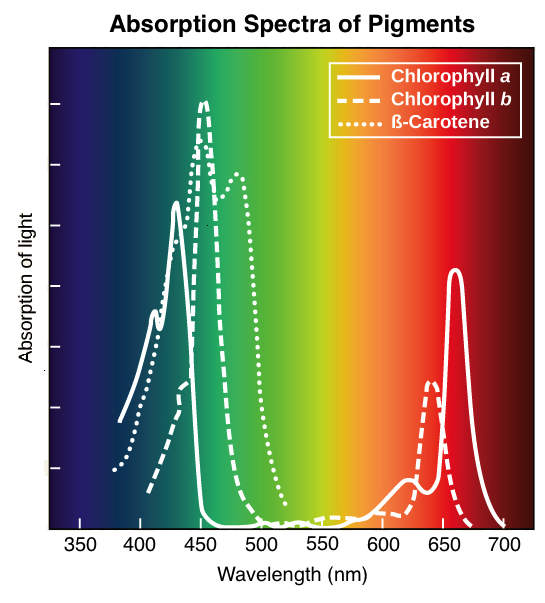
The chemical constituents of Earth's atmosphere also play a role in photosynthesis. If we compare the atmospheric absorption spectrum of visible light with the absorption spectrum of plant chlorophyll, we observe a nice fit at the long wavelengths (
Any major change in the chemical composition of our atmosphere would have an impact on green plants. For example, a higher level of atmospheric oxygen would be bad for plants, while a higher level of atmospheric carbon dioxide would be good for plants. The entire universe, one can easily conjecture, is incredibly intertwined with the intertwining of its own constituents.
Viewing objects beyond our atmosphere has spurred creative scientists and engineers to design and build whole new families of telescopes that can capture high-resolution images of our Universe in many different wavelengths. Some of these "telescopes" are placed in Earth orbit, for example, the Hubble Orbiting Telescope, while other spacecraft orbit or flyby planets and the moons of planets, for example the Cassini Spacecraft orbiting Saturn.
The Cassini mission to Saturn was sponsored by 28 nations and was launched 15 October 1997. Cassini traveled 4.9 billion miles (7.9 billion kilometers) and sent back 635 gigabytes of data, granting Cassini the honor of being among the most extraordinary eyes in the sky before its programmed descent and subsequent crash into Saturn's surface on 25 September 2017, having operated a tad short of two decades.

Another reason for deploying telescopes in space is that our atmosphere is continually changing in density, humidity, temperature, and a few other more esoteric factors. A continually changing atmosphere distorts a telescope's image.
Since the mid-1950s, several nations have flung into Earth orbit (and beyond) numerous satellites carrying numerous sensors for exploring our Universe. Space-based telescopes aboard satellites travel far out into space and radio back huge amounts of data. These new telescopes, or "robots", can "see" in wavelengths not visible to us humans and extend far beyond what Hubble can see (Hubble: sees visible light plus a slice of infrared EMR).
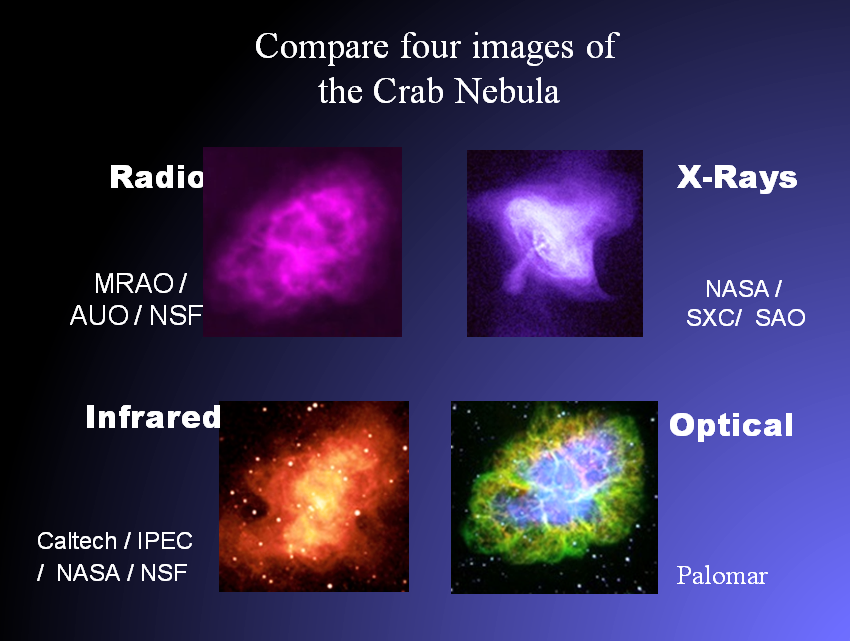
With advances in sensors, space-based telescopes see images in very short wavelengths, which have opened whole new avenues of exploration. Where will these new paths of adventure lead or what worth do they have for humanity and for civilization is not yet known. A dearth of human curiosity and imagination is our only limitation to the acquisition of intellectual and practical knowledge.
The Orbiting Hubble Telescope has been among the most exciting and productive tools in modern astronomy. Hubble's orbit is above nearly all of the Earth's atmosphere, which permits its 2.4-meter (8-feet, 96-inch) main reflector mirror to clearly see objects that are only a hazy smudge of light when viewed from the surface of the Earth.
To further appreciate the benefits of viewing the sky from above our atmosphere, consider the
Microscopes: Seeing the Minuscule
From space, let us return to our desks and see what is going on in the world under a
Microscopes are the tools we use to see things that are
Students view one-celled amoebas and paramecia swimming around in a mere drop of pond water. The complexity of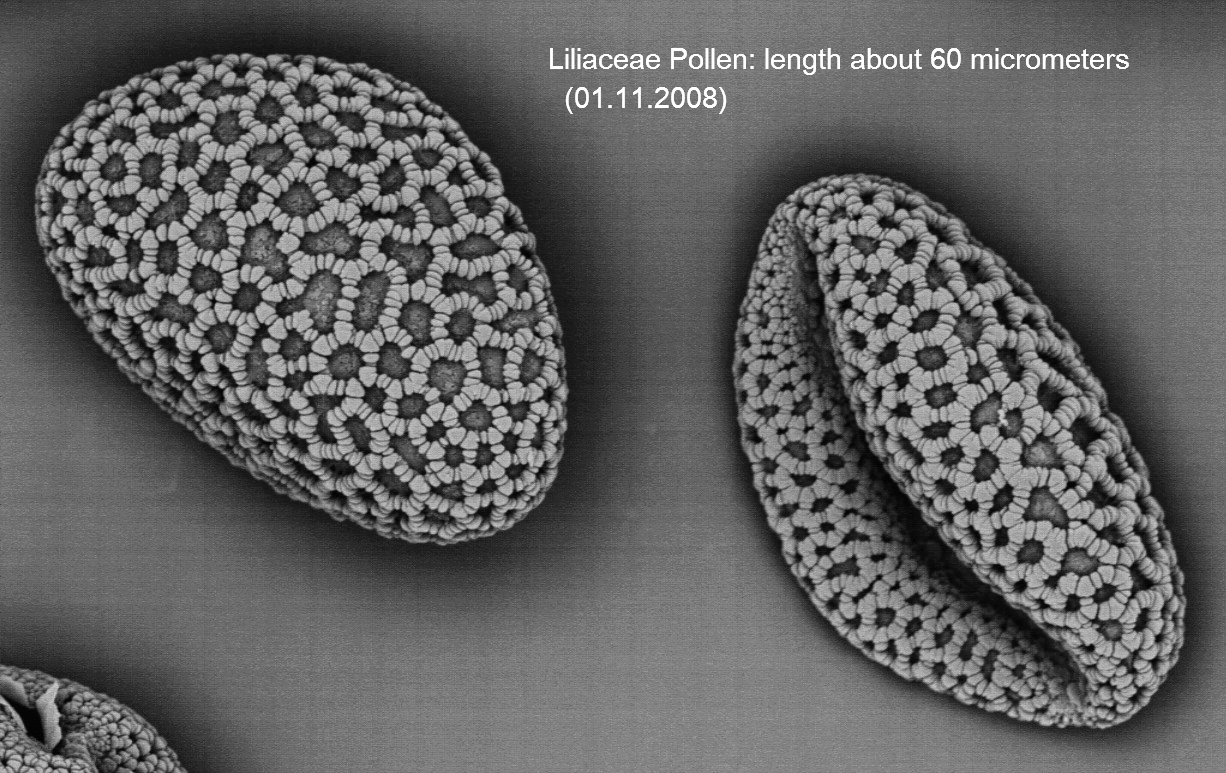
 At higher magnification, a creative artist may be inspired by the beautiful surface texture of a tiny grain of pollen. (Image in Public Domain; Wikipedia
At higher magnification, a creative artist may be inspired by the beautiful surface texture of a tiny grain of pollen. (Image in Public Domain; Wikipedia
At 400x magnification, we can see objects as small as 0.5 mm (millimeters); equaling 500 μm (microns or micrometers, which equals 1 millionth of a meter), a dimension approaching the limit of optical microscopes.
If we want to see smaller details, we must turn to ultraviolet light and x-rays. At this degree of "smallness", small bacteria, internal structures of living cells, and the complexities of blood cells become visible.
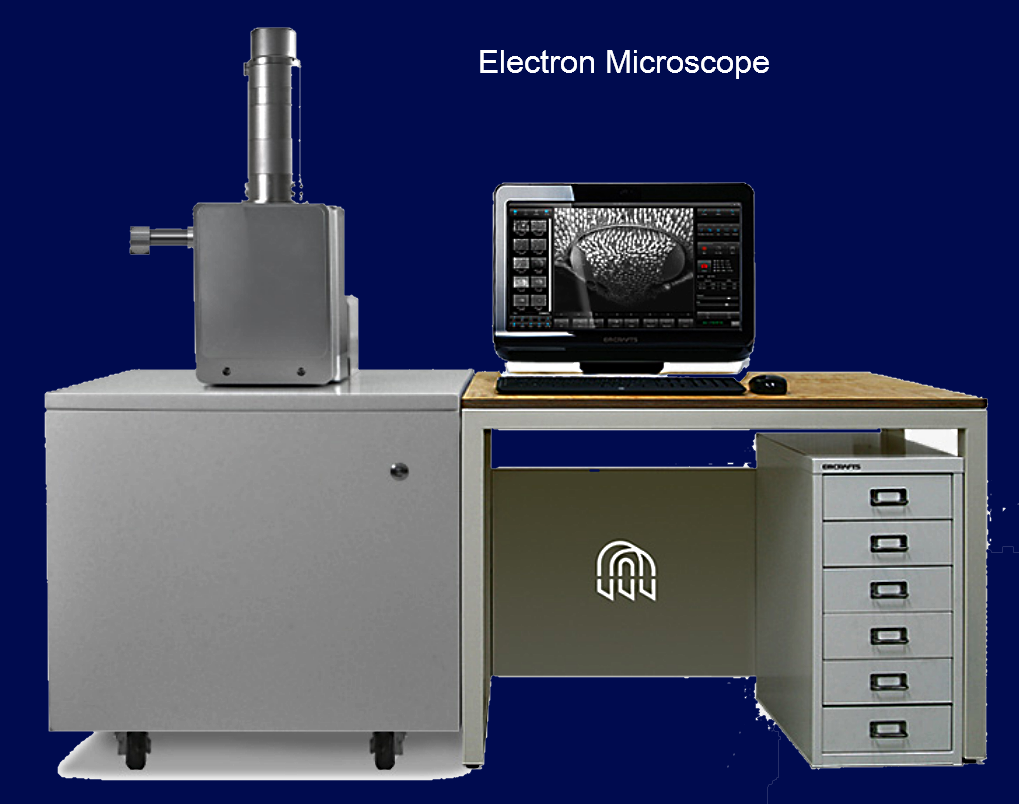
Because of higher magnification available to us nowadays, we can see more and more structure in the seemingly featureless
Review of Metric Units with Respect to One Meter
- ===============================
- ► 1 millimeter = 1 mm
= 0.001 meter;
- thin paper-clip wire is about 1 mm. - ► 1 micrometer = 1 μm
= 0.000001 meter;
- also called a "micron";
- typical bacteria. - ► 1 nanometer = 1 nm
= 0.000000001 meter
- one water molecule;
- present-day central processing (CPU) chips contain billions of transistors, constructed by 7-nm lithography on a thumb-size chip. - ===============================
How Do We See Inside of Atoms?
At the very shortest x-ray wavelengths, we begin to observe the relatively large space between the nucleus of an atom and the electrons whirling around the nucleus. Observing the characteristics of an atom or molecule is possible because the wavelength of extreme x-rays is shorter than the distance between an atom's nucleus and its orbiting electrons.
A Note for the curious: For a radar system to see an airplane, the wavelength of a radar's radio beam must be somewhat shorter than the size of the airplane. Long-range air-traffic control operates around 30 centimeters (1 gigahertz); an airplane is a lot larger than a few centimeters. Athough low-freqeuncy radar systems can detect very large objects, they cannot detect smaller objects, such as fighter jets and automobiles. At shorter wavelength, radar systems can detect smaller objects.

Modern computer chips are formed by shining the light of x-rays on special coatings sprayed onto a silicon base, i.e. substrate. Through a process that is similar to visual-light lithography, transistors, inductors, resistors, and capacitors are formed in layers built-up on the substrate. Wires needed to connect all of these functional elements are also formed on the substrate.
Chip makers have been relentlessly reducing the size of their chips, because small-dimension chips run faster and run cooler than large-dimension chips. The clock speed of the original IBM Personal Computer was 4.77 megahertz; today's average PC runs at a clock speed of 3 gigahertz or higher, the speed of which is on the order of a thousand times faster. What is no less important is that the cost of making these chips has dropped precipitously as the dimensions of the chips have shrunk.
Particle Accelerators
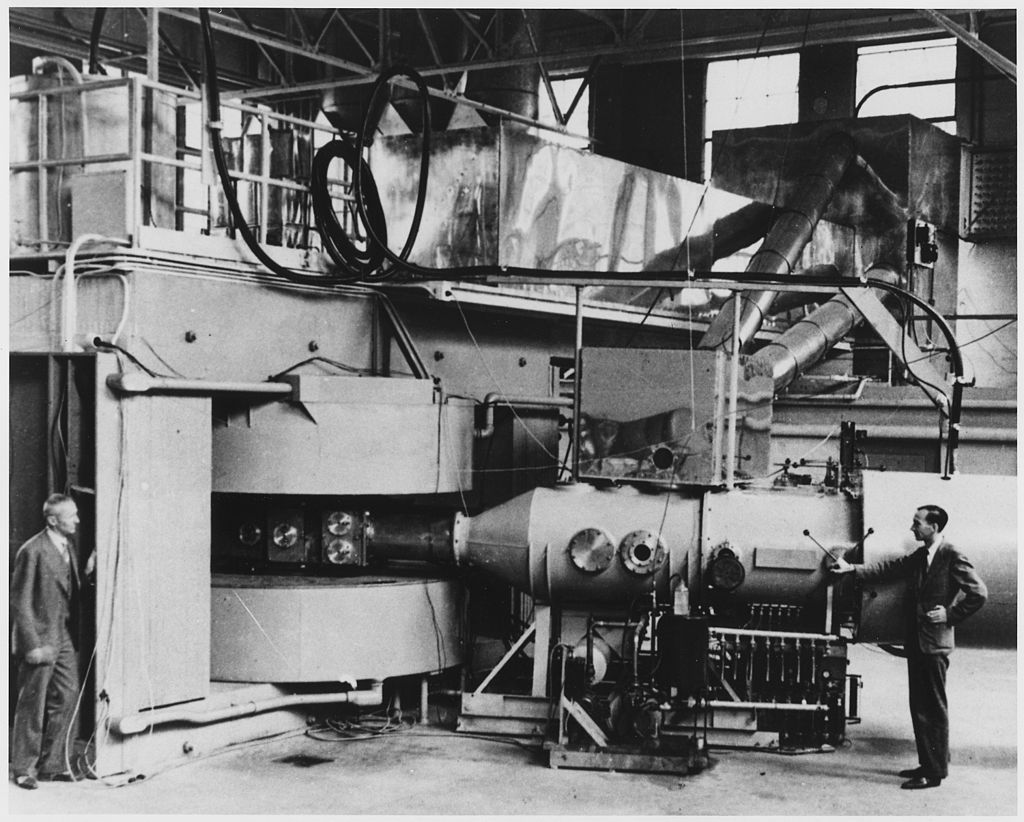
If viewing molecules is not enough, try firing up a
Protons and neutrons have structure and can be split into smaller particles, i.e. particles with strange names, such as "quarks", muons [myoo-ahns], neutrinos, and most recently, the
Although protons and neutrons are very, very small, studying protons and neutrons requires huge, massive, expensive machines to detect, visualize, and explore the innards of atoms. The largest accelerators are round tunnels that confine protons and neutrons (i.e. particles) within a circular, kilometers-circumference, tube-shaped vacuum chamber. Very powerful electromagnets drive the particles around the circle, much like race cars race around a track.
Early accelerators fired one beam of particles into a beryllium or other metallic target and recorded numerous sub-particles that resulted from the collision of the particles with the target. Today, the largest accelerators fire two beams of particles at each other from opposite directions. The collision is like a high-speed, head-on train crash, which produces a shower of smaller particles. The bigger the machine, the smaller the particles detected.
Examining the structure of protons and neutrons at the scale of
The immediate goal for all of this is to have cheap, plentiful, safe
Side Note: One may ask, what is the difference between an
Math Review for the Rusty
A simpler way to write these numbers is called "
Count the
: the area of a square is side 1 × side 2, or ten squared.
: the area of a cube is side 1 × side 2 × side 3, or ten cubed.
represents any number.
For numbers less than one, the





.gif) The breathing holes (inset) on the underside of a green leaf can be seen with an
The breathing holes (inset) on the underside of a green leaf can be seen with an